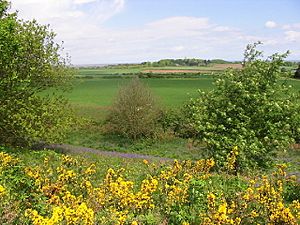Wiveton Downs facts for kids
| Site of Special Scientific Interest | |
 |
|
| Area of Search | Norfolk |
|---|---|
| Coordinates | 52°56′38″N 1°00′43″E / 52.944°N 1.012°E |
| Interest | Biological Geological |
| Area | 28.9 hectares (71 acres) |
| Notification | 1992 |
| Location map | Magic Map |
Wiveton Downs is a special place in Norfolk, England. It covers about 28.9-hectare (71-acre) of land. This area is important for both its living things (biology) and its rocks and landforms (geology).
It's officially called a Site of Special Scientific Interest (SSSI). This means it's protected because it has rare wildlife or important geological features. Part of Wiveton Downs is also a Local Nature Reserve, which helps protect nature for everyone to enjoy. It's also found within the beautiful Norfolk Coast Area of Outstanding Natural Beauty.
Contents
What Makes Wiveton Downs Special?
Wiveton Downs is a very unique place. It's known for its interesting geology and the plants and animals that live there. Scientists and students often visit to learn more about its natural history.
The Amazing Esker Formation
One of the most exciting features at Wiveton Downs is an esker. Imagine a long, winding ridge of sand and gravel. That's an esker!
How Eskers Are Formed
Eskers are formed by ancient glaciers. During the last Ice Age, huge sheets of ice covered much of the land. Meltwater rivers flowed under these glaciers, sometimes in tunnels. These rivers carried sand, gravel, and rocks. When the glaciers melted away, the material left behind in these tunnels formed the winding ridges we call eskers. Wiveton Downs has a great example of one!
Why This Esker Is Important
This esker is considered a "classic example." This means it's one of the best places to study how these landforms are created. It's very important for teaching and research about geology.
Biological Interest at Wiveton Downs
Besides its geology, Wiveton Downs is also important for its biology. While the text doesn't list specific plants or animals, a "biological" SSSI usually means it's home to special habitats. These habitats support unique types of plants, insects, birds, or other wildlife. Protecting these areas helps keep our natural world healthy.

